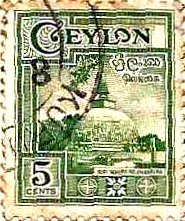 |
| Ceylon 1938-49 KG6 Sigiriya (Lion Rock) 10c |
1938 KG6 Sigiriya (Lion Rock) 10c Ceylon
Text: 10c SIGIRIYA CEYLON
Condition: Ø = used/cancelled
Title: Lion
Rock
Face value: 10
Stamp Currency: Ceylonese
cent
Country/area: Ceylon
Year: 1938-02-01
Set: 1938 Landsmotieven
Stamp number in set: 1
Basic colour: Black / Blue
Exact colour: Light blue, Black
Usage:
Definitive
Type: Stamp
Theme: Rocks
Stamp subject: King George VI and views
NVPH number:
Michel number: 234Y
Yvert number: 255
Scott number: 281
Stanley Gibbons number: 389
Printing office:
Perforation: K 11½ : 11
Size: 90
x 177 mm
Watermark: CA crown, written and failing (multiple)
Paper:
Printing: Steel gravure
Buy Now: Bid Now:
Sigiriya
Sigiriya (Lion Rock Sinhala: සීගිරිය, Tamil: சிகிரியா, pronounced see-gi-ri-yə) is an ancient palace located in the central Matale
District near the town of Dambulla in the Central Province, Sri Lanka. The name
refers to a site of historical and archaeological significance that is
dominated by a massive column of rock nearly 200 metres (660 ft) high.
According to the ancient Sri Lankan chronicle the Culavamsa, this site was
selected by King Kasyapa (477 – 495 CE) for his new capital. He built his
palace on the top of this rock and decorated its sides with colourful frescoes.
On a small plateau about halfway up the side of this rock he built a gateway in
the form of an enormous lion. The name of this place is derived from this
structure —Sīhāgiri, the Lion Rock. The capital and the royal palace was
abandoned after the king's death. It was used as a Buddhist monastery until the
14th century.of the Regency of Marie de' Medici was designed and painted
entirely by Rubens on the spot to replace another, far more controversial
depiction of Marie's 1617 expulsion from Paris by her son Louis. Completed in
1625, this is the final painting in the cycle in terms of chronological order
of completion.






